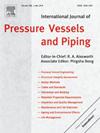Deep transfer learning + BDENet: An innovative approach for detecting the internal defects of weld seams using radiographic imaging
IF 3
2区 工程技术
Q2 ENGINEERING, MECHANICAL
International Journal of Pressure Vessels and Piping
Pub Date : 2025-02-15
DOI:10.1016/j.ijpvp.2025.105467
引用次数: 0
Abstract
The radiographic testing of weld defects is crucial for ensuring welding quality. Identifying these defects is challenging because radiographic images feature low brightness and contrast. The traditional measurement and grading of defect sizes heavily relies on the subjective judgment and operational proficiency of non-destructive testing personnel, which compromises the accuracy and consistency of results. This study proposes an automatic weld defect detection method based on deep transfer learning and BDENet to achieve the precise identification of various weld defects. Firstly, the backbone network was pre-trained on Pascal VOC2012 and SBD datasets. The optimal weights were determined by fine-tuning hyperparameters, which enhanced the feature extraction ability of the model. Subsequently, the datasets were processed using overlapping clipping, which enhanced the datasets and retained more boundary information. Then a novel BDENet model was introduced. The model featured an boundary detail enhancement network (BDENet) consisting of detail enhancement convolution and differential convolution. BDE enhanced the semantic information of boundary details in weld images by integrating prior information and differential features through residual addition. This enhancement significantly improved segmentation accuracy and sensitivity to small-scale features. Finally, the fine-tuned transfer learning technology was applied to the BDENet model. The proposed method outperformed other semantic segmentation models, achieving remarkable metrics: 86.70 % mIoU, 91.17 % mPA, 92.71 % mF1, and 90.99 % mR. These results validate the model's effectiveness, demonstrating its superiority in the semantic segmentation of radiographic images of defects.
深度迁移学习+ BDENet:一种利用射线成像检测焊缝内部缺陷的创新方法
焊缝缺陷的射线检测是保证焊接质量的关键。识别这些缺陷是具有挑战性的,因为放射图像的特点是低亮度和对比度。传统的缺陷尺寸的测量和分级严重依赖于无损检测人员的主观判断和操作熟练程度,影响了结果的准确性和一致性。本研究提出了一种基于深度迁移学习和BDENet的焊缝缺陷自动检测方法,以实现对各种焊缝缺陷的精确识别。首先,在Pascal VOC2012和SBD数据集上对骨干网进行预训练;通过微调超参数确定最优权值,增强了模型的特征提取能力。然后,对数据集进行重叠裁剪处理,增强了数据集,保留了更多的边界信息。然后介绍了一种新的BDENet模型。该模型具有一个由细节增强卷积和微分卷积组成的边界细节增强网络(BDENet)。该方法通过残差加法将先验信息与差分特征相结合,增强焊缝图像边界细节的语义信息。这种增强显著提高了分割精度和对小尺度特征的敏感性。最后,将微调迁移学习技术应用于BDENet模型。该方法优于其他语义分割模型,达到了86.70%的mIoU、91.17%的mPA、92.71%的mF1和90.99%的mr。这些结果验证了该模型的有效性,显示了其在射线图像缺陷语义分割方面的优势。
本文章由计算机程序翻译,如有差异,请以英文原文为准。
求助全文
约1分钟内获得全文
求助全文
来源期刊
CiteScore
5.30
自引率
13.30%
发文量
208
审稿时长
17 months
期刊介绍:
Pressure vessel engineering technology is of importance in many branches of industry. This journal publishes the latest research results and related information on all its associated aspects, with particular emphasis on the structural integrity assessment, maintenance and life extension of pressurised process engineering plants.
The anticipated coverage of the International Journal of Pressure Vessels and Piping ranges from simple mass-produced pressure vessels to large custom-built vessels and tanks. Pressure vessels technology is a developing field, and contributions on the following topics will therefore be welcome:
• Pressure vessel engineering
• Structural integrity assessment
• Design methods
• Codes and standards
• Fabrication and welding
• Materials properties requirements
• Inspection and quality management
• Maintenance and life extension
• Ageing and environmental effects
• Life management
Of particular importance are papers covering aspects of significant practical application which could lead to major improvements in economy, reliability and useful life. While most accepted papers represent the results of original applied research, critical reviews of topical interest by world-leading experts will also appear from time to time.
International Journal of Pressure Vessels and Piping is indispensable reading for engineering professionals involved in the energy, petrochemicals, process plant, transport, aerospace and related industries; for manufacturers of pressure vessels and ancillary equipment; and for academics pursuing research in these areas.

 求助内容:
求助内容: 应助结果提醒方式:
应助结果提醒方式:


